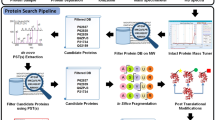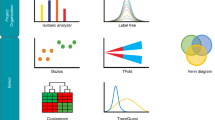Abstract
The characterization of protein modifications is essential for the study of protein function using functional genomic and proteomic approaches. However, current techniques are not efficient in determining protein modifications. We report an approach for sequencing proteins and determining modifications with high speed, sensitivity and specificity. We discovered that a protein could be readily acid-hydrolyzed within 1 min by exposure to microwave irradiation to form, predominantly, two series of polypeptide ladders containing either the N- or C-terminal amino acid of the protein, respectively. Mass spectrometric analysis of the hydrolysate produced a simple mass spectrum consisting of peaks exclusively from these polypeptide ladders, allowing direct reading of amino acid sequence and modifications of the protein. As examples, we applied this technique to determine protein phosphorylation sites as well as the sequences and several previously unknown modifications of 28 small proteins isolated from Escherichia coli K12 cells. This technique can potentially be automated for large-scale protein annotation.
This is a preview of subscription content, access via your institution
Access options
Subscribe to this journal
Receive 12 print issues and online access
$209.00 per year
only $17.42 per issue
Buy this article
- Purchase on Springer Link
- Instant access to full article PDF
Prices may be subject to local taxes which are calculated during checkout




Similar content being viewed by others
References
Hunt, D.F. et al. Characterization of peptides bound to the class I MHC molecule HLA-A2.1 by mass spectrometry. Science 255, 1261–1263 (1992).
Kinter, M. & Sherman, N.E. Protein Sequencing and Identification Using Tandem Mass Spectrometry. (Wiley, New York, 2000).
Kelleher, N.L. et al. Top down versus bottom up protein characterization by tandem high resolution mass spectrometry. J. Am. Chem. Soc. 121, 806–812 (1999).
Sze, S.K., Ge, Y., Oh, H. & McLafferty, F.W. From the cover: Top-down mass spectrometry of a 29-kDa protein for characterization of any post-translational modification to within one residue. Proc. Natl. Acad. Sci. USA 99, 1774–1779 (2002).
Patterson, D.H., Tarr, G.E., Regnier, F.E. & Martin, S.A. C-terminal ladder sequencing via matrix-assisted laser desorption mass spectrometry coupled with carboxypeptidase Y time-dependent and concentration-dependent digestions. Anal. Chem. 67, 3971–3978 (1995).
Chait, B.T., Wang, R., Beavis, R.C. & Kent, S.B.H. Protein ladder sequencing. Science 262, 89–92 (1993).
Tsugita, A., Takamoto, K., Kamo, M. & Iwadate, H. C-terminal sequencing of protein. Eur. J. Biochem. 206, 691–696 (1992).
Vorm, O. & Roepstorff, P. Peptide sequence information derived by partial acid hydrolysis and matrix-assisted laser desorption/ionization mass spectrometry. Biol. Mass Spectrom. 23, 734–740 (1994).
Zubarev, R.A., Chivanov, V.D., Hakansson, P. & Sundqvist, B.U.R. Peptide sequencing by partial acid hydrolysis and high resolution plasma desporption mass spectrometry. Rapid Commun. Mass Spectrom. 8, 906–912 (1994).
Gobom, J., Mirgorodskaya, E., Nordhoff, E., Hojrup, P. & Roepstorff, P. Use of vapor-phase acid hydrolysis for mass spectrometric peptide mapping and protein identification. Anal. Chem. 71, 919–927 (1999).
Shevchenko, A., Loboda, A., Shevchenko, A., Ens, W. & Standing, K.G. MALDI quadrupole time-of-flight mass spectrometry: a powerful tool for proteomic research. Anal. Chem. 72, 2132–2141 (2000).
Lin, S.H., Tornatore, P. & Weinberger, S.R. Limited acid hydrolysis as a means of fragmenting proteins isolated upon ProteinChip Array surfaces. Eur. J. Mass Spectrom. 7, 131–141 (2001).
Reiber, D.C., Brown, R.S., Weinberger, S., Kenny, J. & Bailey, J. Unknown peptide sequencing using matrix-assisted laser desorption/ionization and in-source decay. Anal. Chem. 70, 1214–1222 (1998).
Lennon, J.J. & Walsh, K.A. Direct sequence analysis of proteins by in-source fragmentation during delayed ion extraction. Protein Sci. 6, 2446–2453 (1997).
Keough, T., Youngquist, R.S. & Lacey, M.P. A method for high-sensitivity peptide sequencing using postsource decay matrix-assisted laser desorption ionization mass spectrometry. Proc. Natl. Acad. Sci. USA 96, 7131–7136 (1999).
Shevchenko, A. et al. Rapid de novo peptide sequencing by a combination of nanoelectrospray, isotopic labeling and a quadrupole/time-of-flight mass spectrometer. Rapid Commun. Mass Spectrom. 11, 1015–1024 (1997).
Hillenkamp, F., Karas, M., Beavis, R.C. & Chait, B.T. Matrix-assisted laser desorption/ionization mass spectrometry of biopolymers. Anal. Chem. 63, 1193A–1203A (1991).
Whittal, R.M., Keller, B.O. & Li, L. Nanoliter chemistry combined with mass spectrometry for peptide mapping of proteins from single mammalian cell lysates. Anal. Chem. 70, 5344–5347 (1998).
Solouki, T., Marto, J.A., White, F.M., Guan, S. & Marshall, A.G. Attomole biomolecule mass analysis by matrix-assisted laser desorption/ionization Fourier Transform ion cyclotron resonance. Anal. Chem. 67, 4139–4144 (1995).
Graves, D.J., Martin, B.L. & Wang, J.H. Co- and Post-translational Modification of Proteins (Oxford, New York, 1994).
Jones, J.J., Stump, M.J., Fleming, R.C., Lay, J.O. & Wilkins, C.L. Investigation of MALDI-TOF and FT-MS techniques for analysis of Escherichia coli whole cells. Anal. Chem. 75, 1340–1347 (2003).
Krutchinsky, A.N. et al. Orthogonal injection of matrix-assisted laser desorption/ionization ions into a time-of-flight spectrometer through a collisional damping interface. Rapid Commun. Mass Spectrom. 12, 508–518 (1998).
Loboda, A.V., Ackloo, S. & Chernushevich, I.V. A high-performance matrix-assisted laser desorption/ionization orthogonal time-of-flight mass spectrometer with collisional cooling. Rapid Commun. Mass Spectrom. 17, 2508–2516 (2003).
Schriemer, D.C. & Li, L. Mass discrimination in the analysis of polydisperse polymers by MALDI time-of-flight mass spectrometry. 1. Sample preparation and desorption/ionization issues. Anal. Chem. 69, 4169–4175 (1997).
Schriemer, D.C. & Li, L. Mass discrimination in the analysis of polydisperse polymers by MALDI time-of-flight mass spectrometry. 2. Instrumental issues. Anal. Chem. 69, 4176–4183 (1997).
Vorm, O., Chait, B.T. & Roepstorff, P. Mass spectrometry of protein samples containing detergents. Proc. 41st ASMS Conf. Mass Spectrometry and Allied Topics, 621 San Francisco, CA, May 31–June 4 1993.
Zhang, N., Doucette, A. & Li, L. Two-layer sample preparation method for MALDI mass spectrometric analysis of protein and peptide samples containing sodium dodecyl sulfate. Anal. Chem. 73, 2968–2975 (2001).
Zhang, N. & Li, L. Effects of common surfactants on protein digestion and MALDI MS analysis of the digested peptides using two-layer sample preparation. Rapid Commun. Mass Spectrom. 18, 889–896 (2004).
Nielen, M.W.F. MALDI time-of-flight mass spectrometry of synthetic polymers. Mass Spectrom. Rev. 18, 309–344 (1999).
Dai, Y., Whittal, R.M. & Li, L. Two-layer sample preparation: a method for MALDI-MS analysis of complex peptide and protein mixtures. Anal. Chem. 71, 1087–1091 (1999).
Acknowledgements
This work was supported by the Natural Sciences and Engineering Research Council of Canada, Genome Canada through Genome Prairie's Enabling Technologies Project, Canada Foundation for Innovation, The Protein Engineering Network of Centres of Excellence, and Alberta Cancer Board. We thank Andrew Shaw (Cross Cancer Institute, Alberta) for helpful comments on the manuscript.
Author information
Authors and Affiliations
Corresponding author
Ethics declarations
Competing interests
The authors declare no competing financial interests.
Supplementary information
Supplementary Fig. 1
Expanded MALDI spectra of Figure 2 in the m/z range from 2,500 to 6,000. (PDF 121 kb)
Supplementary Fig. 2
MALDI spectra of 1 pmol of lysozyme. (PDF 166 kb)
Supplementary Fig. 3
MALDI spectra of an HPLC-fractionated sample from an E. coli K12 extrac (PDF 44 kb)
Supplementary Fig. 4
Expanded MALDI spectra of an HPLC-fractionated sample from an E. coli K12 extract after mixing with 6M HCl and applying microwave irradiation for 1 min. (PDF 97 kb)
Supplementary Fig. 5
MAP sequencing of human ubiquitin using different amounts of starting materials ranging from 7 fmol to 7 pmol. (PDF 67 kb)
Supplementary Fig. 6
Effect of SDS on acid hydrolysis with MI. (PDF 181 kb)
Supplementary Table 1
List of proteins characterized by the MAP sequencing technique. (PDF 17 kb)
Rights and permissions
About this article
Cite this article
Zhong, H., Zhang, Y., Wen, Z. et al. Protein sequencing by mass analysis of polypeptide ladders after controlled protein hydrolysis. Nat Biotechnol 22, 1291–1296 (2004). https://doi.org/10.1038/nbt1011
Received:
Accepted:
Published:
Issue Date:
DOI: https://doi.org/10.1038/nbt1011
This article is cited by
-
Peptide Sequencing Directly on Solid Surfaces Using MALDI Mass Spectrometry
Scientific Reports (2017)
-
Quantitative analysis of aberrant fatty acid composition of zebrafish hepatic lipids induced by organochlorine pesticide using stable isotope-coded transmethylation and gas chromatography-mass spectrometry
Analytical and Bioanalytical Chemistry (2012)
-
Comparative analysis of S-fatty acylation of gel-separated proteins by stable isotope–coded fatty acid transmethylation and mass spectrometry
Nature Protocols (2011)
-
HybGFS: a hybrid method for genome-fingerprint scanning
BMC Bioinformatics (2006)



